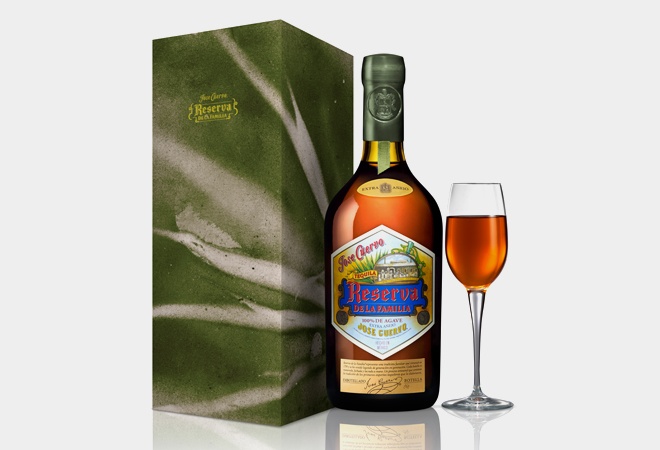Jose Cuervo isn’t exactly a tequila you think of as refined and elegant. It’s more in tune with regrettable nights spent praying to the porcelain god in your friend’s upstairs bathroom, or likened more to cheap margaritas served at your favorite “Tex-Mex” restaurant chain. While we won’t say those predispositions are necessarily wrong, we will say the brand carries a distinct array of history, culture, and yes, quality tequila, that people don’t generally get to savor. Upon the family’s 200th year in the tequila business back in 1995, they chose to celebrate by opening their personal cellars—filled with their private stock of select barrels—to the public.
Every year, the Cuervo family releases Reserva De La Familia, a small batch (and by “small” we mean something like 17,000 bottles) of extra añejo tequila that comprises a careful mix of the select tequila from the family cellar, all of it aged at least 30 years, and tequila from hand-selected agave from their fields.
Most notable about the annual release, however, is the design. The family takes a lot of pride and care in the designing of the box. Every year since the first release in 1995, the Cuervo family has commissioned a well-known Mexican artist to create a special edition box design. Over the last 20 years, the boxes have become highly collectible by tequila snobs, and have featured art by people like Joel Rendon, Mercedes Gertz, Sergio Hernandez, and Marco Arce.
This year, Cuervo teamed up with Mexican-born, Cartier Award-winning artist Mario Garcia Torres to come up with a box design that speaks on Mexico’s history of agriculture, and the importance of the local climate in the tequila-making process.

Torres, 41, lives in Mexico City and was born in Monclova, a city in the northern state of Coahuila, about 11 hours north of Tequila. The significance of this particular project is, to him, immense, because in his mind, Tequila (both the city and the liquor) is reminiscent of a different time and a different Mexico—a Mexico where love, friendship, and truthfulness were the crux of a community, which seem almost entirely absent from the Mexico the world now knows. This project allowed Torres to bring people back to an important era in Mexico’s long history (or introduce them to it for the first time).
As far as the physical artistic process, according to Torres, to create the image on the box, he collected all the plants that grow beside the blue agave. From there, he laid them on canvas, and then sprayed metal dust onto them, leaving an imprint. He then oxidized the metal dust, and the results were the designs that went onto the boxes. Torres says he made several works using the same process, and then two were selected for placement on the box.
Last year’s box, on shelves now, was carefully designed by renowned Mexican artist Jorge Mendez Blake, whose work often explores Mexico’s vibrant history and culture, as well as its physical geography. His box design is a perfect example, as it beautifully represents Mexico’s landscape, mainly the Ceboruco Volcano, an iconic piece of landscape in the Tequila region, and something that’s absolutely critical to the local culture and economy.

The box’s physical design features a black and white painting of the landscape overlaid on the display box. Mendez Blake chose to focus less on the traditional flat agave fields that everyone typically associates with tequila, and more on the plush, rockier geography of the region. The goal was to show people a side of the country’s beautiful Trans-Mexican Volcanic Belt that’s tragically under-referenced in the conversation about tequila.
The work was meant to be displayed as a three-dimensional object, so that it doesn’t lose meaning or structure when printed on the box. Ultimately, Mendez Blake aimed to highlight the relationship between the culture and landscape of the country with tequila, but also focus on the relationship between the booze and Mexican literature. Included inside each box is a small red pamphlet with a traditional Mexican poem imprinted upon its pages. The tequila is good, but the display is truly thoughtful and breathtaking.
For more info on Reserva De La Familia and what makes it so special, check out the website.




